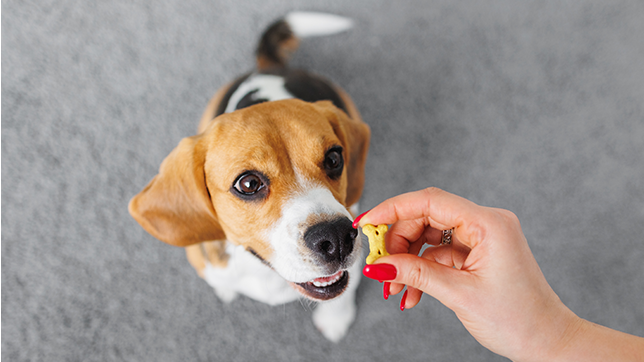17th January 2024
Positive training vs. punishment
Through our Dog Training series, we’re suppawting you and your canine companion as you train them from home. Our efforts to make dog training easy can help set you both up for an amazing future with your pooch!
But there are some important steps to take that’ll help you become greater best friends with your dog as you train them. Perhaps the most significant step of all, positive reinforcement training is vital if you intend to encourage the best behaviour from your dog; and have fun, of course…
What is positive reinforcement training?
Positive reinforcement training is defined as ‘the encouragement of desired behaviour by offering a positive consequence’. So, this means that your dog is rewarded with something positive for performing a behaviour you've asked of them.
Depending on what motivates your pooch most, their reward could be treats, petting, play, and/or verbal praise. To learn more about the different types of reward you could use while training your canine companion, check out our article about finding the right reward for your dog.
How does positive reinforcement training work?
Our canine companions thrive when we give them attention. Thanks to letting them know they’ve done a good job by providing positive reinforcement, we’re giving our pups the confidence to keep trying their best.
It’s essential to discover your dog's favourite ‘high value reward’ early on in the training process, though. Choosing a reward that your dog finds highly motivating will ensure your training sessions with them are always enjoyable, as well as educational! After all, would you prefer to be praised for your hard work, or criticised for making mistakes?
Connecting certain behaviours with something good helps your dog remember what they’ve done and inspires them to repeat that positive action in future.
How to use positive reinforcement
Consistency is the key to success for all types of dog training, though it’s especially important when using positive reinforcement.
An example of the effectiveness of consistent positive reinforcement can be seen when toilet training a puppy:
Step 1 – Your puppy makes the right decision to toilet outside.
Step 2 – As soon as they’ve finished what they’re doing, provide lots of praise and give your puppy their high value reward, so they associate that behaviour with your positive reaction.
Step 3 – The more you praise them and give them a reward for toileting outside, the more your puppy will want to repeat that behaviour, until it becomes second nature.
If you consistently reward your dog for doing what you ask or expect of them, the training journey will be easier for both of you!
What is punishment training?
Punishment training is intended to stop a dog from performing undesirable behaviours by punishing them whenever they do something wrong.
In terms of dog training, the different types of punishment include:
- Shouting
- Hitting
- Withholding food.
- Withholding toys.
- Withholding affection.
Here at Animal Friends, we wholeheartedly believe that positive reinforcement is the best type of training.
It’s also crucial to highlight the fact that punishment training goes against the Animal Welfare Act 2006, and your dog’s legal rights to:
- Live in a suitable environment.
- Eat a suitable diet.
- Exhibit normal behaviours.
- Be protected from pain, suffering, injury, and disease.
The reasons punishment training doesn't work
Negative reinforcement and punishment training are cruel and ineffective.
Here are just a few of the many reasons it's unacceptable to punish a dog, at any point in their training journey:
- Harsh punishments can damage the trust between dog and owner.
- Causing pain or fear for a ‘mistake’ may lead a dog to repeat that behaviour out of sight. For example, punishing a puppy for peeing on the carpet may result in them hiding to pee behind the sofa instead, to avoid being caught and punished.
- There's a chance a dog wouldn’t understand what they're being punished for, because negative reactions are often slower to appear. An example of this would be an owner discovering their puppy has toileted in the house a few minutes after it’d happened. Punishing the puppy couldn’t help them learn what they’ve done wrong, because they wouldn’t link the punishment with toileting indoors – instead, associating their owner with an unpleasant experience.
- Punishment can make dogs feel insecure and wary of their owners. Not only does this result in them ‘reoffending’ (because they can’t learn through negative training forms) but can also cause them to become defensive and lead them to react aggressively.
We do understand that training your pooch can be frustrating at times, though no-matter how challenging it can be, always use positive training methods. Taking a break when things get too much, so both you and your dog can reset and refresh, will make a positive difference to your next training session.
Please avoid using punishment and negative techniques at all costs.
Ultimately, then, the best and only way for you to train your dog well is by using positive reinforcement. Training your furry best friend is an incredibly rewarding experience – especially when you make every session special, thanks to providing plenty of praise and positivity!
Can't get enough of our tail-wagging training? Make sure you’re following our Facebook, Instagram, and TikTok accounts for regular ‘pupdates’ and top tips.

